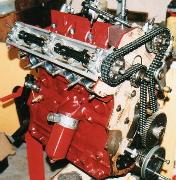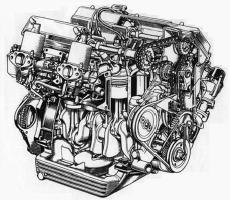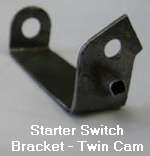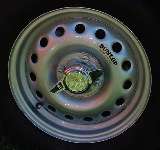The MGA With An Attitude
MGA TWIN CAM - General Information - TC-102

Most people know something about the MGA Twin Cam engine with cross flow head and carburetors on the right, and the knock-off steel wheels, and the four wheel disk brakes. But there are far more features of the Twin Cam model that are different than the basic pushrod engine cars, so much so that the Twin Cam body is not interchangeable with others without considerable modification. You may refer to Twin Cam Engine General Information for more detail about the special engine.
 There are a number of frame and body modifications done to accommodate installation of the twin cam engine. The steering rack and radiator are moved forward, the bonnet is crowned higher (carried over into all other models) with different inner brace pattern, different prop rod position and a small frame relief to clear the front carburetor. The inner fenders have removable access panels (except not on the first 91 cars). inner "dimples" to clear the distributor (left front) and air cleaners (right side) duplicated on all successive cars, radiator mount diaphragm moved forward, and shortened air pan in front. The heater box is a mirror image from the pushrod engine cars with the air intake duct on the opposite side, the cut-out in the shelf also offset to the opposite side, a different pattern for the bolts between heater shelf and frame goal post, and the heater water valve is mounted on the heater inlet pipe rather than on the engine.
There are a number of frame and body modifications done to accommodate installation of the twin cam engine. The steering rack and radiator are moved forward, the bonnet is crowned higher (carried over into all other models) with different inner brace pattern, different prop rod position and a small frame relief to clear the front carburetor. The inner fenders have removable access panels (except not on the first 91 cars). inner "dimples" to clear the distributor (left front) and air cleaners (right side) duplicated on all successive cars, radiator mount diaphragm moved forward, and shortened air pan in front. The heater box is a mirror image from the pushrod engine cars with the air intake duct on the opposite side, the cut-out in the shelf also offset to the opposite side, a different pattern for the bolts between heater shelf and frame goal post, and the heater water valve is mounted on the heater inlet pipe rather than on the engine.
Special chassis refinements for the Twin Cam car included a change to Dunlop four wheel disc brakes, pin drive knock-off steel wheels, and separate master cylinders for brakes and clutch. The Twin Cam clutch master and slave cylinders are smaller bore, so attempting to use a standard clutch slave cylinder on the Twin Cam will result in too little travel of the clutch and no clutch release. The Twin Cam has a different gearbox (borrowed from the ZB Magnette), double flanged propshaft (used also later in the1600 cars), and special rear axle similar to the wire wheel axle except slightly rotated end flanges. Front suspension is similar to other MGA (except for the brakes). Twin Cam steering arms are slightly diffferent (one of four variatione of steering arms on various models).
 The Twin Cam uses a higher capacity fuel pump with a different mounting bracket on the frame, and a slightly different location for the starter switch bracket (and different bracket) for carburetor clearance. You may refer to Twin Cam Chassis Tech for more detail about variations in the frame, body, and running gear of the Twin Cam car. When the "Deluxe" cars were built with pushrod engine and the "Competition suspension" option, most of the Twin Cam chassis and body changes were retained, except the heater box was switched back to right hand air inlet. As such, the "Deluxe' cars have another special and unique body shell.
The Twin Cam uses a higher capacity fuel pump with a different mounting bracket on the frame, and a slightly different location for the starter switch bracket (and different bracket) for carburetor clearance. You may refer to Twin Cam Chassis Tech for more detail about variations in the frame, body, and running gear of the Twin Cam car. When the "Deluxe" cars were built with pushrod engine and the "Competition suspension" option, most of the Twin Cam chassis and body changes were retained, except the heater box was switched back to right hand air inlet. As such, the "Deluxe' cars have another special and unique body shell.
For outward appearance some holes in the front body cowling and the deck lid are in slightly different location for mounting the "Twin-Cam" emblem vs. the "1-6-0-0" or "1600-MK-II" emblems. Aside from the badging, the only other outward appearance clue for the Twin Cam model is
 the use of different wheels, which were soon to be shared with the "Deluxe" model cars. Original wheels for the Twin Cam are special pin drive steel wheels with knock off center mount.
the use of different wheels, which were soon to be shared with the "Deluxe" model cars. Original wheels for the Twin Cam are special pin drive steel wheels with knock off center mount.
Inside the cockpit the Twin Cam dash panel is covered with textured fabric and trimmed with a bright plated strip along the bottom and a bright trim plate in the center around the radio speaker and horn push. The body cowling on top between the dash and the windscreen is NOT covered with textured fabric for the roadster, which was not done until the 1600-MK-II model, after that last Twin Cam. The Twin Cam coupe did have the fabric covering on the cowling, same as all MGA coupes. The Twin Cam tachometer has a higher reaching number scale on the face commensurate with the higher expected engine speed (7000 R.P.M. marked red line).
Competition/deluxe seats were often installed in the Twin Cam cars, as these cars were generally considered more as a competition model than a common street cruiser. They were also often built with close ratio gearbox and high ratio rear axle for competition work.
The aluminum hardtop was sometimes (but rarely) installed on a Twin Cam roadster. Records of this seem to be limited to factory sponsored competition cars (only 5 on record). In each case these cars did NOT have an erectable fabric top installed due to luggage space requirements of the various racing organizations. If you see a Twin Cam roadster with a hardtop, it is likely not a factory original installation, especially if it also has a rag top. As hardtops were available through the dealers and various aftermarket sources, any MGA roadster might carry any type of hardtop as a dealer or aftermarket fitment. As a personal choice current owners of Twin Cam cars usually prefer the aluminum hardtop, first made for the 1500 models and commonly fitted to the "Deluxe" cars while the aluminum top and fiberglass top had overlapping production runs.
|


 The Twin Cam uses a higher capacity fuel pump with a different mounting bracket on the frame, and a slightly different location for the starter switch bracket (and different bracket) for carburetor clearance. You may refer to
The Twin Cam uses a higher capacity fuel pump with a different mounting bracket on the frame, and a slightly different location for the starter switch bracket (and different bracket) for carburetor clearance. You may refer to 